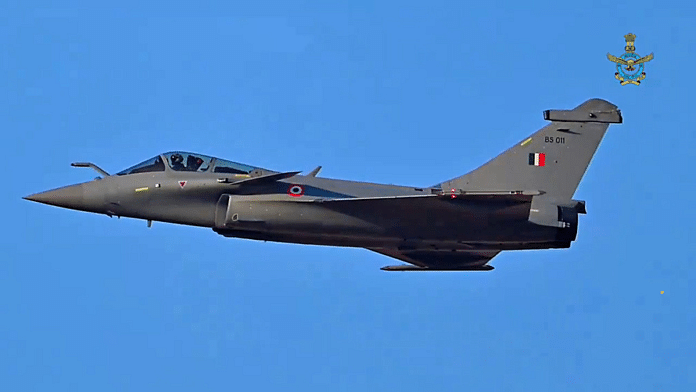In the aftermath of Operation Sindoor, Chinese disinformation has become a key instrument in shaping not only the India-Pakistan narrative but also global perceptions of the French military-industrial complex. For China, this is about more than regional rivalry; it is about asserting itself as a credible arms supplier in a market long dominated by the West. A recurring line in Chinese discourse is that “India’s Rafale cannot compete with China’s J-10C.”
French military intelligence recently disclosed to Associated Press that Chinese defence attachés have been attempting to undermine Rafale sales by pressuring countries like Indonesia to reconsider their procurement plans in favour of Chinese-made alternatives. The Chinese strategic community and online commentators have dismissed this as “yet another coordinated smear campaign against the country’s diplomacy”.
The claims, however, align with a broader trend of anti-Rafale sentiment across Chinese digital platforms, where the fighter aircraft is frequently described as “outdated, overpriced, and ill-suited” for contemporary combat, especially since Operation Sindoor. On Weibo, a Phoenix TV post suggested that Rafale’s performance may force a re-evaluation of its global combat reputation. One user claimed that the jet had left many countries disillusioned with Western military technology, prompting renewed interest in Chinese options.
“After being smashed in the India-Pakistan air battle, Rafale’s image crumbled, and France blamed China to save face,” read one such comment. Another argued that even the most advanced jets are ineffective without integrated combat systems—something China claims to possess while France doesn’t.
Rafale vs J-10CEs
In China, a dominant narrative is that during the 7 May aerial clashes, India’s Rafales were decisively outmatched by Pakistan’s J-10CEs. The supposed shortcomings of Rafale noted by Chinese commentators include limited radar range, shorter missile reach, sluggish electronic countermeasures, and lower agility. Some Chinese commentators argued that even experienced Western pilots could not have turned the tide.
Beyond combat performance, Chinese commentary portrayed Rafale as maintenance-heavy, logistically burdensome, and poorly integrated with India’s mixed fleet.
Li Jie, a senior researcher at the PLA Naval Military Studies Research Institute, argued that Rafale’s recent showing would likely prompt prospective buyers to reassess its value. Some Chinese critiques portray the entire French defence industry as outdated and overpriced, trailing China in areas such as engine development, nuclear capability, and aerospace technology.
According to this view, France is shifting the blame for Rafale’s failings onto Indian pilots in order to deflect attention from deeper design flaws. Some even claim that France may struggle to stay competitive in civil aviation within a decade.
Also read: Why is South Asia strategic studies declining in US? All alignment, no depth
China’s opportunity
In Chinese discourse, France’s focus on alleged Chinese interference is being portrayed as a diversion and a sign of desperation. Commentators view this as a turning point for China’s defence industry.
A suspected Rafale crash in Egypt is being cited as further evidence of the aircraft’s high maintenance demands. Chinese reports claim Egypt is now favouring the J-10CE for its affordability, proven combat record, and rapid delivery.
Wang Mingliang, a researcher at the Academy of Military Sciences, said the engagement speed is crucial, noting that while the Pakistani Air Force takes just 12 seconds to complete its “kill chain”—from detecting a target to engaging and neutralising it—the Indian Air Force takes 30 seconds. He also declared that Indonesia’s defence ministry is reassessing its $8.1 billion Rafale deal and requesting additional technical verification from France.
Also read: Iran-Israel need win-win solutions, not jingoistic brinkmanship
Unfailing optimism
Following the 2025 Paris Air Show, Chinese analysts are struggling to make sense of the low sales of J-35s as compared to Rafale and American F-35. A Chinese analyst lamented that despite its tarnished combat record, Rafale secured new orders, while China’s advanced J-35, having impressed the crowds, failed to sell. This highlights that arms procurement depends on more than technology; political alliances, logistical support, and training ecosystems heavily influence decisions, the analyst wrote.
A viral post on Weibo summed it up: “Buying the F-35 is protection money to the US; buying Rafale joins the EU’s circle of friends. China offers arms without strings but also without political protection. China’s non-alignment policy limits its appeal in markets where geopolitical cover is as crucial as military hardware.”
Nevertheless, the Paris disappointment is being viewed as a transitional phase—a gradual but inevitable rebalancing of the global arms trade. As China expands defence partnerships and broadens its network, it is said, these barriers will diminish.
The broader opinion remains that once Chinese arms shed their geopolitical liability, their uptake will reshape the global defence market and China will emerge as the undisputed winner.
Sana Hashmi is fellow at the Taiwan-Asia Exchange Foundation. She tweets @sanahashmi1. Views are personal.
(Edited by Prasanna Bachchhav)







“India’s Rafale cannot compete with China’s J-10C.” The Chinese are holding onto this narrative, because of their own insecurity. They self-proclaimed many times in the past that China is way past the USA in fighter jet manufacturing, they building a sixth fighter jet. Now when their fighter jet failed to perform it’s giving them a lot of pain. So parroting the above statement, they’re sympathizing themselves.